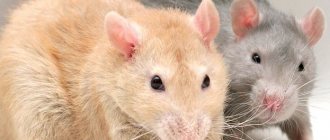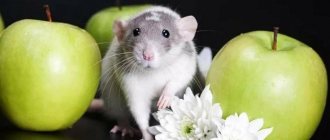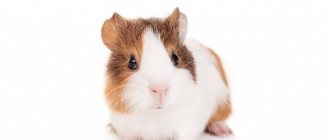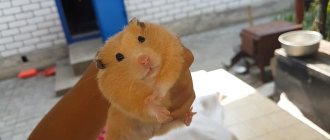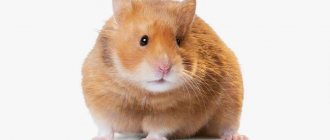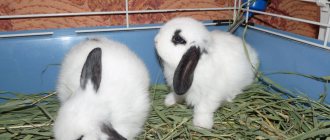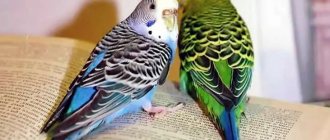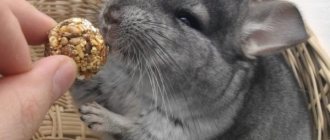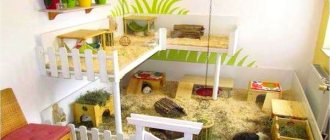02/03/2015 Category: Pets Author: Natalya Ivantsova
A decorative rat is often bought as a small and, at first glance, inconspicuous alternative to a dog or cat for a child who has worn out his parents with requests for a pet. I must say, the alternative is more than worthy, because according to some data, rats are much more intelligent than other domesticated four-legged animals that traditionally live in our apartments.
- Breeds of rats
- How to keep a pet rat
Cell
- What to feed
- Is it possible to swim?
- How to train
- How to catch
Why did rats become pets?
The history of keeping rats by humans dates back to the 19th century, when they were kept for spectacular fights with dogs and for laboratory purposes. In the 1840s to 1860s, rat catcher Jack Black and rat-dog fight organizer Jimmy Shaw began selling rats of interesting colors to keep as pets.
Interest in decorative rats gradually grew and nowadays these smart rodents have become very popular. Organizations and clubs dedicated to decorative rats have been created all over the world; many people choose these particular pets as their companions.
The relationship of decorative rats to humans
Modern decorative rats are harmless to people; many of those who keep these animals note that their pets have never shown aggression towards them. Moreover, unlike hamsters or decorative mice, rats show interest in humans, they interact with humans if they do not offend them. Many of these long-tailed pets are ready to play with their owner for hours and then, tired, fall asleep in the folds of their clothes.
By coat color
Decorative rats are also conventionally divided into several groups according to the type and color of their coat.
Homogeneous (Self)
Rodents of this species have absolutely the same coloring throughout their entire body. Rats are black, white, blue (color with a silver tint. Russian blue and smoky blue are also found. They are very similar in color, the former have a dark color and a light belly, and the latter have a more pronounced blue tint.
Rats in gray-brown tones with a silver-bluish tint with cherry eyes are called mink. There is also an American mink species, these animals have a darker eye shade.
Light gray color with a cool blue tint. The eyes are black or dark red. This is a platinum shade.
Blue, platinum rat
The beige color of the rats resembles coffee with milk. And completely white animals with red eyes are usually called albinos.
Very beautiful coloring of rats - champagne. This species of animal has a light, slightly pinkish color. The eyes are pink.
Russian silver is an interesting light gray color with a blue tint. This variety is characterized by fuzzy ripples of color.
The main color of the “dav” species is pale gray with a pinkish tint. It has a characteristic light ripple. Rat "Lilak" - light ash color, slightly mixed with chestnut color. Eyes black or dark cherry.
Officially unrecognized colors of domestic rats:
- Chocolate;
- Russian beige;
- Caramel.
Ticked colors
They are distinguished by uneven coloring of the hairs, that is, there are places on them that may have pigments of different colors.
Agouti
This coloring is characterized by a beautiful chestnut color. Some hairs are black. Short and medium hairs have bands. They must be free of orange and yellow, and it is better if they are of the lightest shades.
The base color consists of a dark gray or light brown tint. The ends of the hairs are black and the belly is silver-gray.
Rat – Agouti
There is also a blue agouti - the belt of hairs can be red and brown, and the belly is light gray-blue with inclusions of silver hairs.
Incredibly beautiful shade of platinum agouti. This bright color is combined using two colors: light gray and beige with a cool blue tint. Each hair has a light blue base with a beige edge. The belly is light silver.
Amber (Amber)
Rich color of yellow and orange shades. Each hair has an ivory border. The guard hairs have a silvery tint. The undercoat is cream and the belly is light. The eyes are pink.
Amber color
Cinnamon
Rodents are colored in red-brown tones with inclusions of darker guard hairs, which have bright golden and red edgings. The belly is gray with silver, and the eyes are black or cherry.
Faun
These rodents have a beautiful coffee color with a golden tint with the inclusion of silvery guard hairs. There is a not very expressive golden-red pattern. The belly is cream and silver, and the eyes are the color of dark ruby.
Breed – Fawn
Topaz
This color is similar to the Fawn color, however, it is not as rich and has a lighter undercoat.
Pearl
This species has a light, silvery tint. Eyes black or dark ruby. There are also 2 subspecies: Pearl cinnamon and Pearl blue. The first color consists of three colors: beige, golden and light gray.
Overall, it is golden with a silvery tint. Eyes black or dark ruby. The second color is light with beige and gray shades. Each hair is silver-gray in color. The belly is grayish-beige, and the eyes are black or dark cherry.
Pearl rat
Silver colors
The uniqueness of this color lies in the variation of silver and colored hairs in the same number. It should be obvious and designed to create the impression of brilliance and sparkle. If there are inclusions of white hairs, then the color is no longer recognized as silver.
- Silver-black. The color of such rodents is deep black with uniform inclusions of silver hairs. The eyes are black.
- Silver blue. The color is gray with a blue tint. Individual hairs are silvery-white. The undercoat is light gray with a blue tint.
- Silver mink. Deep brown color with a gray tint. Has the same amount of silver and brown hairs.
Combined colors
This category includes the colors of rats, consisting of a combination of several colors.
Siamese
The animal has a beige color that darkens in the back of the body, moving from the lower back to the tail, and also from the belly to the upper back. The tail is dark at the base along its entire length. The rodent has brown spots on its ears, legs up to the elbows and on its face.
Siamese rat
Additionally there are:
- Siamese with black eyes. The color is standard for this species, the eyes are dark.
- Siamese blue. It has a cream color with a silver tint that darkens on the back of the body.
- Siamese Russian Blue. The color is beige, gradually darkening in the back of the body. There are dark brownish spots.
Himalayan
Snow-white color, which is uniform throughout the body. There are dark brown spots. The eyes are red. The paws are slightly colored. The Black-eyed Himalayan is a white rodent with cream spots.
Burmese
Has an even brown color. Wheaten Burmese - the animal has a sandy color with spots of slightly darker tones. The hairs have a yellowish band and a light silver-gray belly.
Breed – Burmiz
Sable
Coffee coloring with dark spots on the paws.
Where can I buy a decorative rat?
You can easily purchase a rat at a pet store, but it is better to purchase it at a specialized nursery, as the animal will cost more, but it will help to avoid many problems in the future.
There is an opinion that rats are tenacious and omnivorous animals, but in fact, rats are prone to many diseases. Treating such a small animal is difficult and quite expensive due to the fact that the courses of treatment are quite long and the medications are expensive. In addition, many veterinarians accept the animals themselves as exotic, which also entails additional costs.
Types of breeds
First of all, it is worth understanding that each breed has its own individual characteristics. Animals of different breeds have different builds, sizes, fur and colors.
So, let's look at how they are distinguished:
- By body type. Dumbo and standard.
- By type of wool. Standard, hairless, wavy, downy, rex.
- By color. Single-color, combined, three-color, mosaic, silver, husky.
- Marking. The color base is predominantly white.
Why you shouldn’t keep different-sex decorative rats together
Decorative rats are collective animals, so they are not kept alone. If an animal is lonely, it experiences stress, which negatively affects its health and life expectancy. Animals of different sexes should also not live together, otherwise they will multiply non-stop. Experienced rat breeders have a negative attitude towards the reproduction of rats outside nurseries, because this primarily harms the rats themselves and their future offspring.
One or many.
In nature, rats live in large groups. They have very pronounced social behavior. Therefore, it is ideal to keep at least two animals. Anyone who, for various reasons, wants to keep only one rat should consider being with it for at least 6 to 8 hours a day. The rats' need for warmth and closeness to the person who cares for them can only be taken into account by taking them on or under your clothes. In this, rats are very similar to dogs: they, just like dogs, are social pack animals, for which a person is the leader, and they also need, if possible, to be in the company of their person all day long. If you keep a large number of rats, they do not become attached and tamed so quickly, we can recommend the following method: first take only one rat and only after 2 - 3 weeks buy a second rat, which will be a social and play partner for the first. It is best to unite two animals that are not familiar with each other, preferably of the same age, on “neutral” territory - that is, not in a cage - and under supervision. Young rats usually get used to each other easily.
Basic food for decorative rats
The basis of the rats' diet is grain mixtures. Additionally, animals are fed fermented milk products without sugar, with a fat content of less than 5%, meat, as well as vegetables and fruits. There are nipple and ball drinkers. It is best to purchase the type that the rat used before it became your pet. You should immediately ask the seller about this. If the rat has previously removed its thirst from a bowl, then in addition to the drinking bowl, at first it is worth putting a bowl of water in the cage, because not all rats immediately start drinking from the drinking bowl. As a rule, if one learns to drink from a drinking bowl, others learn very quickly too.
There should always be something to chew on in the cage; it could be a special mineral stone purchased at a pet store, or branches of an apple or cherry tree, doused with steam.
Growth and development of babies
Little rats grow very quickly. In the first week of life, they gain 3 g of weight every day. Babies actively suck mother's milk, which has high nutritional value. It contains almost 9% protein, the same amount of fat and 4% lactose.
In the first days of their lives, rat pups are constantly near their mother. She moves them from place to place to warm everyone with her body. Small animals do nothing but eat and sleep. On the second day, hungry babies may begin to make a barely audible squeak. Approximately 4 days after birth, the ears of rat pups rise. Now they can hear.
Already on the 4-5th day of life, you can determine what color the little rat pups will have. In light-colored rat pups, the skin remains pink, while in dark-colored pups, it acquires a grayish tint. During this period, the first soft fluff appears on the body.
At the age of one week, baby rats' incisors begin to emerge. The molars will appear no earlier than in 3 weeks. In some individuals they grow only on the 35-40th day of life.
The rate of tooth growth depends on the individual characteristics of the animal and diet.
One of the most significant periods in the life of little rats is the time when their eyes open. This occurs 14-17 days after birth. At first a small gap appears between the eyelids, but after a couple of days the babies begin to see.
From this moment on, the little rats become more active and begin to crawl out of the nest. They look around with great curiosity, go around every corner of the cage, learn to wash themselves and clean their fur. By the way, by this time it has already completely grown back. Between the 15th and 20th days of life, females develop nipples.
At 3 weeks of age, the pups look like their adult counterparts. Their body length reaches 14-15 cm, but the tail is still short. At 25 days the animals become completely independent. Females are already capable of becoming pregnant, but this is undesirable, since the body is not yet fully formed and strengthened. The development of rat pups continues until they are one year old.
What to do before buying a rodent
You need to prepare for the appearance of a rat in advance so that the animal does not experience unnecessary stress and does not sit in a box while you are looking for a cage. You need a large cage, at least 1.2 m3 per animal. It is better to look for such “living space” among cages for ferrets, chinchillas, and rabbits.
The distance between the rods should be about one centimeter, more is possible, but only for adult and large rats, otherwise your pet will constantly escape from the cage. To keep females, it is better to choose tall cages, that is, those where height prevails over length; girls love to climb. Male rats are more clumsy and lazy; for them it is better to choose a cage that is not high, but long.
When can you let your rat out for a walk?
Decorative rats should be let out of their cages for a walk; if the animal has been in your house for a long time and you have taken good care of it, then believe me, it will not rush under the nearest closet. It will be very interesting for you to watch how the rat explores “new horizons”. The main thing is to keep away wires and electrical appliances, as well as objects that a rat can try.
Important notes before purchasing a rodent
When choosing a rat, you should pay attention to the animal’s activity and its interest in the world around it. If an animal hides in a corner and looks detached, then it most likely has health problems. The new pet's coat should be thick and shiny, without bald spots. Scratching too often is a sign of skin problems. The rat's breathing should be smooth, almost imperceptible. If a pet candidate breathes heavily, with whistling or wheezing, it is better to abandon him.
Males or females?
The question of what sex of rats to purchase is important when they want to breed these animals or, conversely, in no case want to have offspring from them. As a rule, females get along very well with each other and especially if they were born in the same litter or were collected quite early. Males have a harder time getting used to each other. Animals of the same strength and age always engage in battles for leadership. The best thing is to unite males of different ages. Males have two rounded testes, or seminal testes. They are clearly visible in young animals already from the fourth week of life. They can be seen or felt at the beginning of the tail. In males, the distance between the anus and the genital opening is clearly greater than in females, which, in addition, have two, in most cases, poorly visible rows of nipples. Some distinctive features between males and females can only be established in adult animals: most often, males are somewhat larger and heavier (their weight reaches approximately 600 g) than light and agile females. They are usually calmer, more balanced and affectionate than females, but they emit a more pungent odor. They are more curious and often also more capable. However, like many mammal species, rats also have large individual differences. None of them are identical animals.
Habits of rats
Rats are very cheerful animals, many of them are like kittens, they love to run after a string and wrestle with their owner’s brush. But when playing, it’s worth remembering that these pets are smaller than you and you need to handle them carefully. If you are buying an animal for a child, it is worth explaining and showing him how to handle a new family member, as well as being present during the child’s first contacts with a rat.
If you are still in doubt whether to get a decorative rat or not, then think carefully. Indeed, despite the small size of this animal, a decorative rat needs no less care than a cat or dog.
